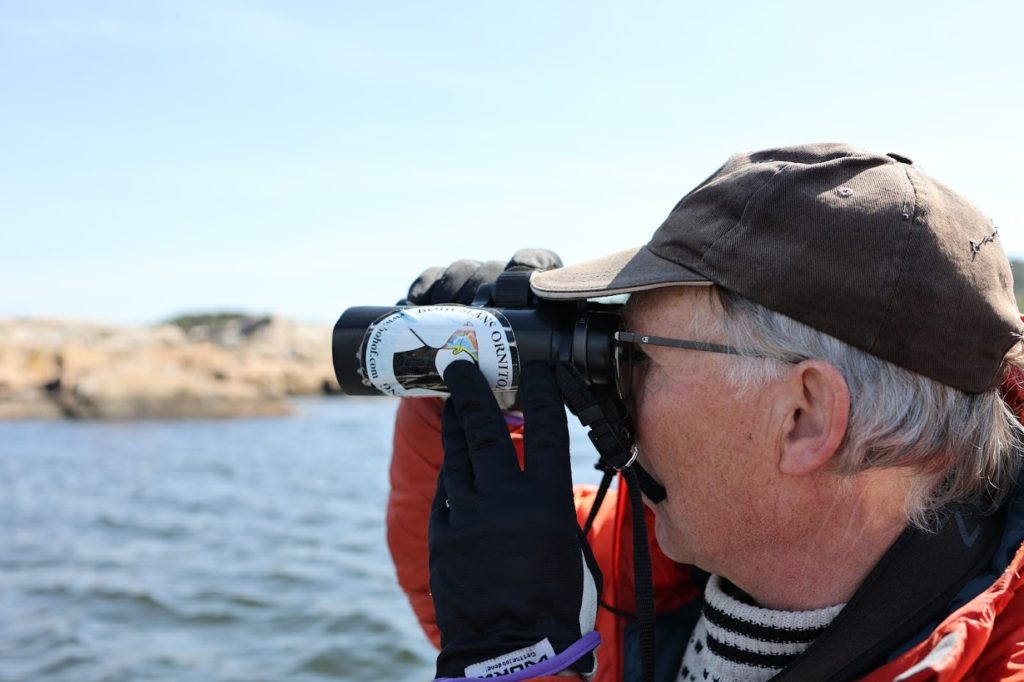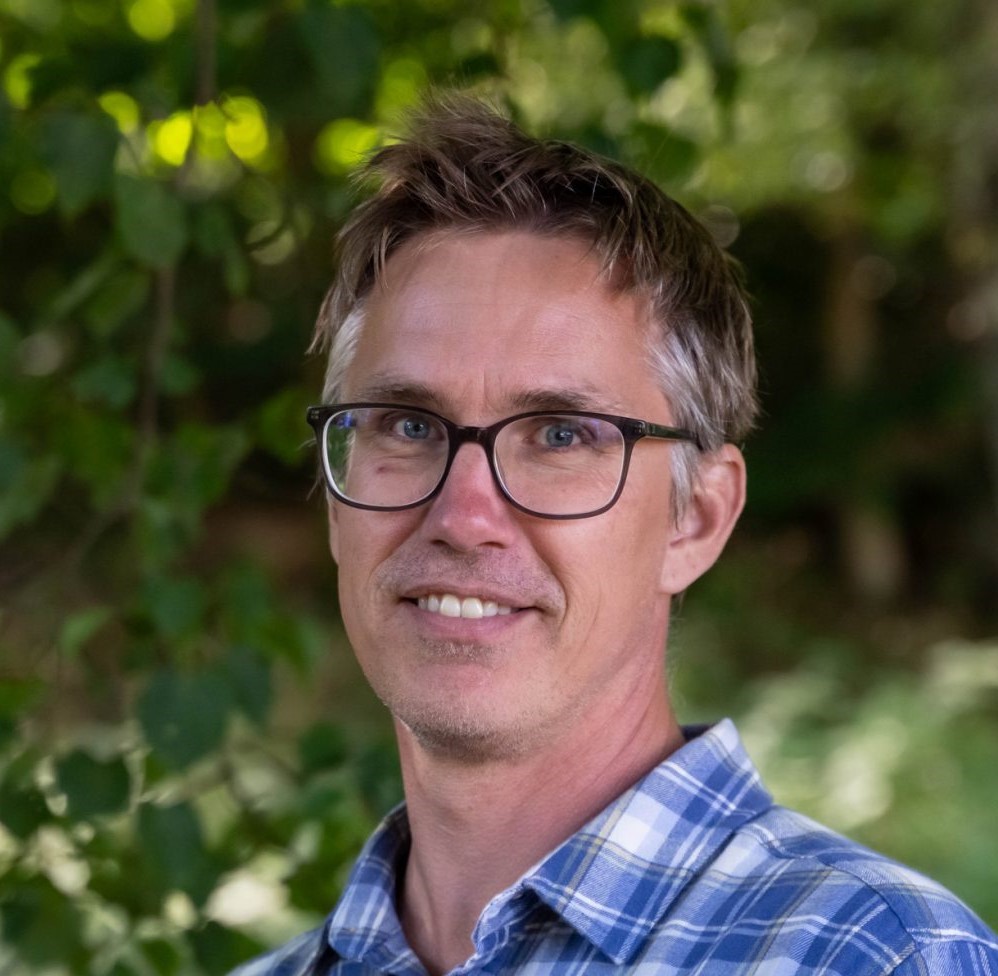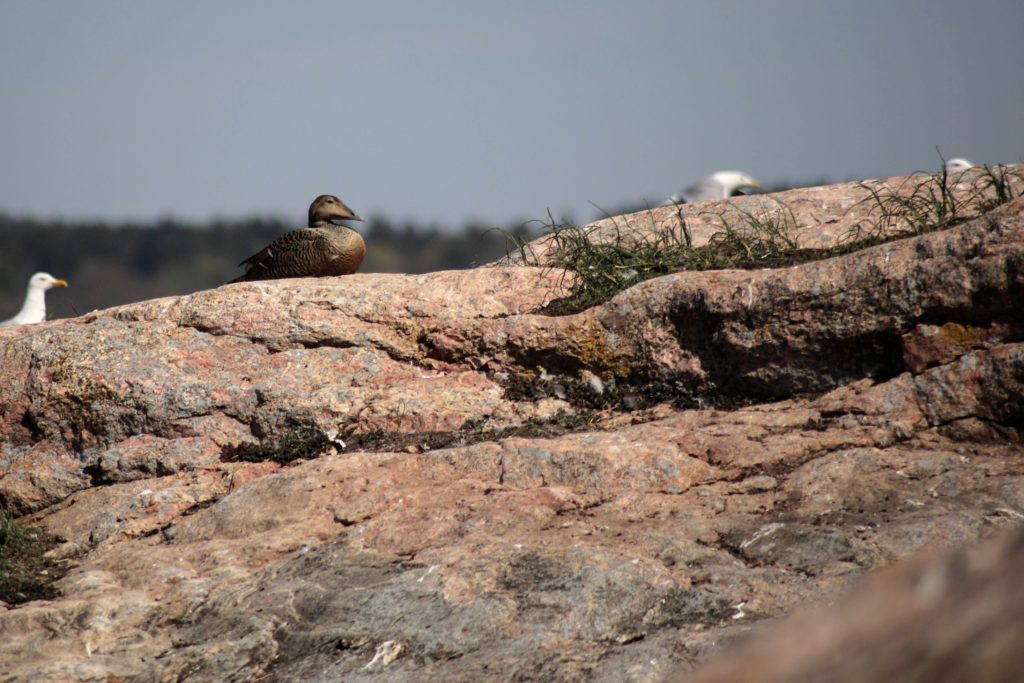
The Swedish government has decided to not meet the targets in the EU’s biodiversity strategy while at the same time money for nature conservation is decreasing. GP maps how species in Western Sweden are being affected by politics
“Either you don’t have the knowledge or you don’t understand the seriousness,” says Mattias Lindholm at Västkuststiftelsen.
Here and there on the bare bird island of Ringburen, just outside Uddevalla, the female eiders lie and incubate their eggs. They share the site with other shorebirds such as herring gulls, oystercatchers, and lesser black-backed gulls. A pungent scent sticks in the nose when an eider leaves its nest.
“To confuse predators, the female shoots faeces on top of the eggs,” says biologist Jan Uddén.
He carefully creeps around the rocks and counts birds, nests, and eggs. Jan Uddén has been doing this in the fjords between Orust and Uddevalla since 1979. For the eider and most gulls, the trend has been strongly downward in the last two decades. The eider, which mainly eats blue mussels, peaked in the 1990s when eutrophication in the sea caused the mussel banks to grow in size and number. At that time, there were more than 4,500 pairs of eiders in the area. Now that number is around 900.
“That peak was not a healthy sign because it was due to eutrophication, but now the eiders are very few. It has gone steadily downwards since the mid-2000s,” says Jan Uddén.
The eider’s decline in Sweden is not fully understood but can be explained by a lack of food, diseases and to some extent predators such as mink. Then there’s also hunting for male eiders, but on a small scale. The females are protected because there are fewer of them and there has been excess mortality. Also, too few of their young survive. On the East Coast, there are also problems with the sea eagle taking young and the weakest female eiders.
“The biggest problem is that the blue mussels are becoming fewer and contain less protein, partly due to warmer water. It has become three degrees warmer since the 1980s, which is a lot,” says Jan Uddén.


Sweden is not expected to reach targets
According to the Swedish Environmental Protection Agency, the trend for eiders can be reversed with more resources and targeted efforts. Among other things, it involves implementing an international action programme, increasing bird protection areas and ensuring that resources for mink hunting are available.
Sweden has committed to improving the eider’s status through the EU’s Birds Directive. There is no end date, but it is in the EU’s biodiversity strategy for 2030. The strategy states that member states must improve the status, or at least achieve a strong positive trend, for 30 percent of the species and habitats that had an unfavourable status in 2019.
“It is not legally binding, but Sweden, like all other member states, has supported the strategy,” says Helene Lindahl at the Environmental Protection Agency.
However, the government decided in March this year not to increase the level of ambition, which means that the targets will not be reached. In the eider’s case, this means that the deterioration is expected to continue until 2030, as well as for several other species.
“They had been flagging for it for a while, but we had at least hoped for scenario two, where the state does a little more.”
Less money for nature conservation
In the EU’s Species and Habitats Directive, as well as in the Birds Directive, species and habitat types that should be preserved are listed. For example, Sweden has a responsibility to preserve large areas of coniferous forest found here, known as the taiga. In mountain environments, a negative trend for the taiga can be reversed by 2030, while the forecast is that it will continue to have a poor status in the rest of the country.
Funds for the protection of valuable nature decreased by 32 percent in 2023 compared to last year. For measures for valuable nature, the funding has been reduced by 45 percent. The reduction is planned to continue until 2026, according to the government’s calculations in the spring budget. Mattias Lindholm, head of nature conservation at Västkuststiftelsen, believes that it complicates the work with nature conservation.
“It has looked tough in the past, but in the last ten-year period it reached a level where it would probably actually work. Then this budget came and everything was demolished. Now we stand there with our nice fences and the fields we have to manage, but we can’t afford it,” he says.

The County Administrative Board in Västra Götaland and the Västkuststiftelsen mainly manage nature conservation in the region. Part of their work is to look after reclaimed land, and old agricultural and grazing land, such as coastal meadows and heather heaths.
Several such habitat types have a poor or unsatisfactory status and within these areas there are many threatened species. Many are accommodated within the EU’s Species and Habitats Directive and within the biodiversity strategy for 2030. The areas must be managed regularly for them to maintain their natural values, for example through grazing.
“It is worrying. We will probably see a regrowth of the land and the open landscape we have here disappearing to a large extent, especially within the protected areas – the ones that we thought everyone wanted to preserve,” says Mattias Lindholm.
Expensive with contractors and cows
Due to fewer resources, the County Administrative Board cannot afford contractors, for example to combat invasive species. According to Anna Stenström, biologist at the Board, this is a big problem because they have attached people with special skills.
“You can’t just send out any old excavator to dig Canadian golden rice. They must recognise Canadian golden rice,” she says.
Another problem is the availability of grazing animals on the islands, as it is too expensive to ship them out.

“Who will graze on our nature reserves if you cannot pay for farmers with cows? The County Administrative Board has no cows. The West Coast Foundation has no cows,” says Anna Stenström.
Large knowledge gaps
Anna Stenström works with species that have an action programme; the so-called ÅGP species. These need targeted efforts to cope in the long run. This was work that was already underfunded, she believes.
“We have calculated that we have previously received ten, perhaps fifteen percent of the money required to implement the action programmes. Now it's halved,” says Anna Stenström.
One ÅGP species she works with is the natterjack toad. It could have gained an improved status on the west coast if the government had chosen scenario two in its commitments. Then, for example, more money could have been spent on creating spawning environments where it is not out-competed. At the same time, there is much that is not known about why things are going badly for the natterjack toad.
“We haven't had the means to inventory it sufficiently. It is simply too expensive to send people out into the Archipelago,” says Anna Stenström.
“You could have put a researcher on it, but there are no research funds.”
Anna Stenström is not surprised that the government chose the least ambitious scenario, but she is tired of environmental policy.
“What bothers me is that you decide on environmental goals and strategies, but then you never take the consequences. You pretend that you have to reach the goals without doing anything.”
Mattias Lindholm agrees with the criticism.
“I don't understand. Either you don't have the knowledge or you don't understand the seriousness behind this, because we won't reach these goals that we have to reach to cope with the future. We're losing species faster than we're getting them back, on every level. There is no area today that is doing well,” he says.
Continued deterioration for the eider
The birds return to the island immediately after the inventory is complete and Jan Uddén steers the boat towards the harbour. With climate change, he finds it difficult to predict how the eiders will fare better in the long run. In the short term, there are concrete solutions, he believes. One such is to create blue mussel banks solely for the eiders and give the growers the same compensation as they receive for human consumption.



“Then the eider should be protected completely. How can a hunter tell if he is shooting a male that is not suitable for reproduction or one that is strong and healthy? It doesn't work,” he says.
According to the Swedish commitments, the deterioration of the eider's status is expected to continue until 2030. At the same time, there’s an urgent need to reverse the trend, according to Jan Uddén.
“We’re at a tipping point now. Around 2012 we saw that things started to go really bad and the future is a cloudy crystal ball.”
We have sent questions to Climate and Environment Minister Romina Pourmokhtari without receiving an answer.
THE THREE SCENARIOS
Scenario 1: "Continued implementation scenario"
Same pace of site protection as the period 2000 to 2021. Equivalent funds as in 2021 for measures such as management.
Scenario 2: "Government lead scenario"
Based on what can be done by state authorities and companies within state land, water and activities and with increased resources beyond what is already included in scenario 1.
Scenario 3: "Needs-based scenario"
Reflects the total need for initiatives, including outside government land and water, to achieve the objectives of the EU Biodiversity Strategy 2030 in Sweden.
RED LISTED SPECIES AND ÅGP SPECIES
In the Species Database's red list from 2020, there are 4,746 red-listed species, of which 2,249 are threatened. The red list is updated every five years.
The Swedish Environmental Protection Agency (133) and the Norwegian Sea and Water Authority (22) have created action plans for 155 species that require special efforts to survive. These are called ÅGP species.
By: Ella Daneshmand, Sandra Daniel, Heino Ollin, Peter Seenan
This article is part of “Crossborder Journalism Campus”, an Erasmus+ project of the University of Gothenburg, Leipzig University and Centre de Formation des Journalistes in Paris. Additional reporting: Suzanne Vink
- Sweden abandons EU targets on biodiversity – draws strong criticism
- Sverige överger EU-mål om biologisk mångfald – väcker stark kritik
